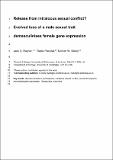Files in this item
Release from intralocus sexual conflict? Evolved loss of a male sexual trait demasculinizes female gene expression
Item metadata
| dc.contributor.author | Rayner, Jack | |
| dc.contributor.author | Pascoal, Sonia Christina Marques | |
| dc.contributor.author | Bailey, Nathan William | |
| dc.date.accessioned | 2019-04-23T11:30:07Z | |
| dc.date.available | 2019-04-23T11:30:07Z | |
| dc.date.issued | 2019-04-17 | |
| dc.identifier | 258432952 | |
| dc.identifier | 033f1132-b3a1-4ccf-8014-fcdffd8af6f7 | |
| dc.identifier | 31014218 | |
| dc.identifier | 85065328035 | |
| dc.identifier | 000465657800020 | |
| dc.identifier.citation | Rayner , J , Pascoal , S C M & Bailey , N W 2019 , ' Release from intralocus sexual conflict? Evolved loss of a male sexual trait demasculinizes female gene expression ' , Proceedings of the Royal Society B: Biological Sciences , vol. 286 , no. 1901 , 20190497 . https://doi.org/10.1098/rspb.2019.0497 | en |
| dc.identifier.issn | 0962-8452 | |
| dc.identifier.other | ORCID: /0000-0003-3531-7756/work/60888396 | |
| dc.identifier.uri | https://hdl.handle.net/10023/17580 | |
| dc.description | Funding: Bioinformatic analyses were supported by the University of St Andrew Bioinformatics Unit (Wellcome Trust ISSF award 105621/Z/14/Z). This work was supported by funding to N.W.B. from the UK Natural Environment Research Council which is gratefully acknowledged (NE/I027800/1, NE/G014906/1, NE/L011255/1). | en |
| dc.description.abstract | The loss of sexual ornaments is observed across taxa, and pleiotropic effects of such losses provide an opportunity to gain insight into underlying dynamics of sex-biased gene expression and intralocus sexual conflict (IASC). We investigated this in a Hawaiian field cricket, Teleogryllus oceanicus, in which an X-linked genotype (flatwing) feminises males’ wings and eliminates their ability to produce sexually selected songs. We profiled adult gene expression across somatic and reproductive tissues of both sexes. Despite the feminising effect of flatwing on male wings, we found no evidence of feminised gene expression in males. Instead, female transcriptomes were more strongly affected by flatwing than males’, and exhibited demasculinised gene expression. These findings are consistent with a relaxation of IASC constraining female gene expression through loss of a male sexual ornament. In a follow-up experiment we found reduced testes mass in flatwing males, whereas female carriers showed no reduction in egg production. In contrast, female carriers exhibited greater measures of body condition. Our results suggest sex-limited phenotypic expression offers only partial resolution to intralocus sexual conflict, owing to pleiotropic effects of the loci involved. Benefits conferred by release from intralocus conflict could help explain widespread loss of sexual ornaments across taxa. | |
| dc.format.extent | 8 | |
| dc.format.extent | 310883 | |
| dc.language.iso | eng | |
| dc.relation.ispartof | Proceedings of the Royal Society B: Biological Sciences | en |
| dc.subject | Demasculinisation | en |
| dc.subject | Feminization | en |
| dc.subject | Intralocus sexual conflict | en |
| dc.subject | Sexual dimorphism | en |
| dc.subject | Sex-biased gene expression | en |
| dc.subject | Teleogryllus oceanicus | en |
| dc.subject | QH301 Biology | en |
| dc.subject | DAS | en |
| dc.subject.lcc | QH301 | en |
| dc.title | Release from intralocus sexual conflict? Evolved loss of a male sexual trait demasculinizes female gene expression | en |
| dc.type | Journal article | en |
| dc.contributor.sponsor | The Wellcome Trust | en |
| dc.contributor.sponsor | NERC | en |
| dc.contributor.sponsor | NERC | en |
| dc.contributor.sponsor | NERC | en |
| dc.contributor.institution | University of St Andrews. School of Biology | en |
| dc.contributor.institution | University of St Andrews. Centre for Biological Diversity | en |
| dc.identifier.doi | 10.1098/rspb.2019.0497 | |
| dc.description.status | Peer reviewed | en |
| dc.identifier.grantnumber | 105621/Z/14/Z | en |
| dc.identifier.grantnumber | Ne/I027800/1 | en |
| dc.identifier.grantnumber | NE/G014906/1 | en |
| dc.identifier.grantnumber | NE/L011255/1 | en |
This item appears in the following Collection(s)
Items in the St Andrews Research Repository are protected by copyright, with all rights reserved, unless otherwise indicated.

